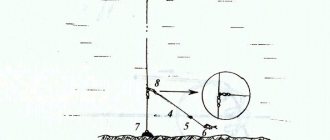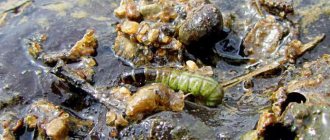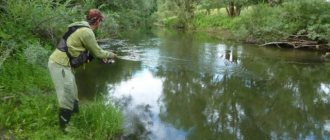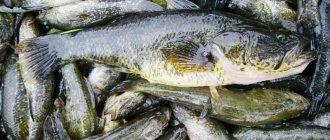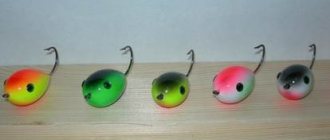In this article, we examined for you the process of making a pike girder with your own hands, talked about its correct equipment, installation and features of fishing with its use for predators in the summer.
The classic version of a pike fishing rod is a slingshot carved from wood or made from wire with equipment wound on it.
The main components of the girder equipment are:
- durable monofilament line;
- sliding lead olive sinker;
- thin metal leash with swivel;
- double or triple hook.
Use such simple gear throughout the open water season to catch not only pike, but also large perch and pike perch.
You can fish with girders on such reservoirs as:
- flowing lakes and ponds rich in thickets of aquatic vegetation;
- small rivers and streams with fallen trees, flooded snags, thickets of water lilies and reeds;
- backwaters of large rivers and large reservoirs.
The main advantages of the zherlitsa include:
- ease of manufacture;
- fairly quick installation;
- the most common self-hooking of pike that has swallowed live bait;
- no need for constant monitoring.
Among the disadvantages, many anglers point out a certain passivity of girder fishing - in most cases, the pike takes live bait and hooks itself when the fisherman is not around.
Also, the disadvantages of this gear include the very frequent breakage of the line due to the fact that the hooked fish goes into nearby reed thickets or snags and there the line gets tangled in underwater stems or submerged tree branches.
As a result, the fisherman has no choice but to break the line, losing both the catch and a significant part of the equipment.
Do-it-yourself summer girder
With the arrival of summer, most reservoirs begin to be overgrown with aquatic and coastal vegetation. In addition, there are other underwater surprises that limit the use of spinning rods. As a rule, pike are found in hard-to-reach places, so the problem can be solved with the help of a girder.
For those who regularly catch pike with girders in winter, it will not be difficult to convert winter gear to summer gear. Unfortunately, there are fishermen who do not have information regarding the construction of girders. Basically, the vent is made from simple and affordable materials, sometimes unsuitable for other purposes. If you have to fish on a river, then you need to think in advance about how the tackle will be attached.
Do-it-yourself summer bait for pike. What could be simpler?
Types of girders for summer fishing
As can be seen in the photo of summer vents, according to their design features they are divided into:
- Postavushi.
- Hanging.
- Moored.
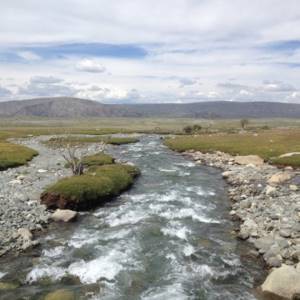
Each type differs not only in equipment, but also in the installation method.
«>
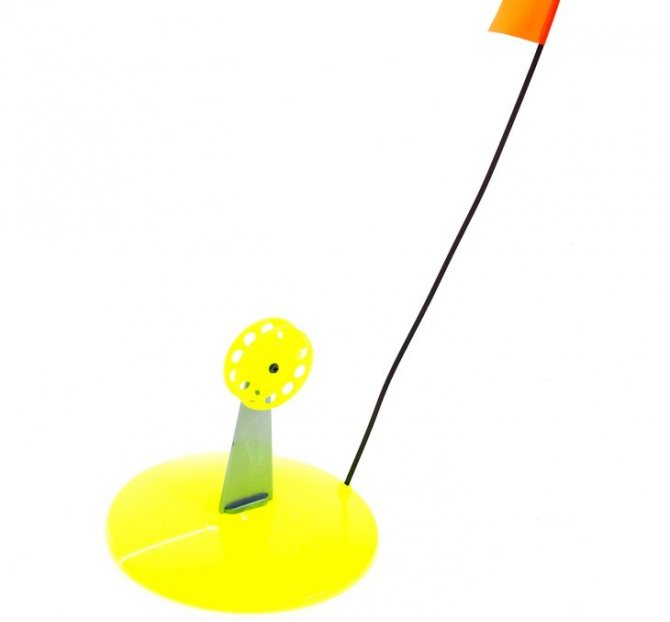
Design features of the vent
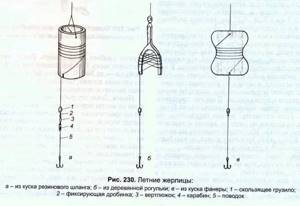
You can find many different designs of such gear. The most important thing is to find elements of gear on which a certain amount of fishing line can be wound. This could be a piece of wood, a plastic bottle, or a plastic circle that can float on water. There are designs of girders that are installed on the water, but they need to be regularly monitored, otherwise the pike may pull it into snags. These are the so-called circles, which are considered one of the varieties of zherlitsa.
One of the ends of the fishing line must be attached to a base of the type mentioned above (for example, a plastic bottle).
The fishing line is wound around this element so that, with a certain effort, it can be easily retracted. At the other end of the fishing line, a tee (hook) is tied and a sliding weight is installed. The base of the girder (frame) must be securely fastened to the shore, otherwise the tackle can be dragged away by a large pike or pike perch.
In case of a bite, the line is slightly pulled off the base, which allows the predator to swallow the bait. After all the line is reeled in, the fish hooks itself.
How to make a slingshot
So, what is the above-mentioned zherlitsa and how to make it with your own hands? And this will have to be done in any case if there is a desire to catch pike with this tackle. Please note: in our fishing stores such gear is usually not sold, unlike winter girders, which are on sale, and often of a variety of designs. Catching pike with flags, also called winter fishing with girders, requires more complex gear, although fishermen also often make it with their own hands. The production of the zherlitsa begins with its main part - the reel, which is a flyer-fork made of coastal bushes or a reel with two forks, cut out of plastic or organic glass. A plastic flyer will be more functional. The forks treated with fine sandpaper will be smoother than those on a flyer made from the fork of a coastal bush. And the fishing line should be thrown off the flyer without difficulty, so as not to alert the predator. In addition, a flyer made of plexiglass or vinyl plastic is heavier, which means it will sway less in the wind and “talk” the baitfish, which is also affected by the wave. Live bait lives much shorter under such unfavorable conditions. I often had to observe how a dried and very light girder made of coastal willow dangled from side to side under gusts of strong wind. Such looseness sometimes even leads to the overlap of the cord attaching the pole to the pole. But most of all, such jerks under the blows of the wind affect the fishing line, tugging it and the bait.
Fishing with blacks, made from Japan, is no less famous than Aksakova and Sabaneeva, and successfully catches in our modern technologies and dreams. Equally, slingshots are flyers with a not very wide opening so that the fishing line can be wound more freely. Cut, remove the bark and be sure to dry the flyers. At the top of the base there is a high-rise or survival hole into which a strong nylon cord is inserted and tied in a simple loop. You can cut a cord in this groove. What is this cord for? A loop of nylon cord is folded into the hand in the form of a blind loop, thrown over six people and tightened tightly.
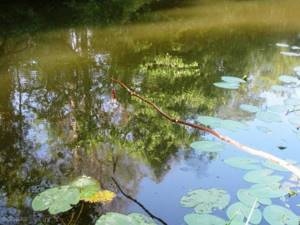
Equipment for summer vents
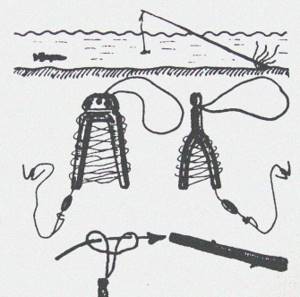
To arrange a summer barn you will need:
- The place where the pier will be attached to the shore. This can be a specially prepared stick or coastal vegetation can be used: trees, bushes or branches of overhanging trees.
- As the basis of the girder, it is possible to use elements prepared at home or elements found on the shore of a reservoir. For example, you can easily find a wooden flyer or a plastic bottle. For the initial clamping of the fishing line, cuts in the wood or rubber rings are used, which securely hold the fishing line until the bite.
- A fishing line with a thickness of 0.4-0.6 mm and a length of 15-20 m is suitable as the main fishing line. It is not recommended to install longer sections of fishing line, as the pike can get caught in snags. Using a very short length will not allow the pike to swallow the bait.
- Sliding weight with swivel. The weight of the cargo is selected depending on various factors, such as the size of the bait and the presence of a current.
- The swivel is needed to connect the leash. Especially needed when there is a current.
- Retaining rings will limit the movement of the load along the fishing line.
- A metal leash is required. Its length is 30 cm.
- Any type of hooks can be installed, both single, double and triple. It is possible to install two leashes with hooks, but no more, so as not to complicate the fishing process.
If you have a boat, then installing the vent in the right place will not be difficult. It is extremely difficult to install summer girders from the shore, without a boat, especially if there are coastal thickets. Although this is not a problem if you take off your clothes, especially since it’s summer outside and not cold winter.
How to equip pike girders in winter
Whatever the design of pike girders in winter, they all have one thing in common – the equipment. At first glance, the rigging for pike in winter is simple - line, sinker, leash and hook. Measure the working depth, plant the bait and lower it into the hole. But in fact, there are a number of features that must be followed, otherwise fishing may not be successful.
The equipment of a winter girder for pike is adjusted based on the fishing conditions, as well as depending on the winter period and the size of the expected trophy. Let's look at how to properly equip a girder for pike fishing in winter.
Coil tuning and modification
In order to properly adjust the girder for pike in winter, you need to check the tightening torque of the reel screw. The reel bobbin should turn easily, but not completely - otherwise a beard may form when the pike jerks sharply. Normal tightening of the coil is when, after acceleration by hand, it turns 5-7 turns and stops. Accordingly, when the tightening is strong, the screw needs to be loosened; if the coil is spinning for too long, on the contrary, tighten it. Most often, ordinary cheap plastic reels are installed on the vents.
Homemade crafts use plastic reels for fishing rods. This point needs to be checked on them too - it’s critical. In the dead of winter, a cautious pike can simply throw the bait if it feels excessive resistance. On good fishing rods for pike in the winter, reels from the store are of satisfactory quality. On cheap Chinese replicas, it is better to replace this element with a more reliable one. The factory flag is usually replaced with a larger and brighter one to make it more visible. When fishing at night, you can apply light-accumulating phosphorus varnish to it - this will make it even more noticeable.
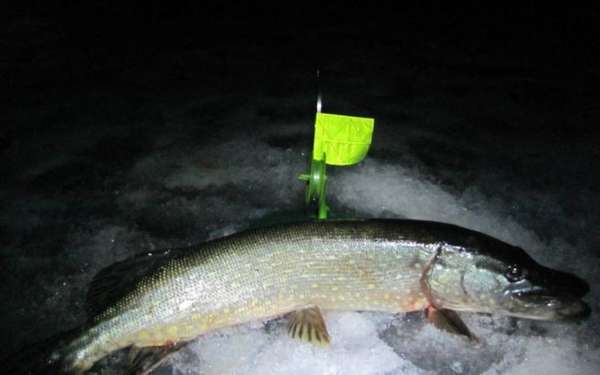
Standard equipment
How to properly assemble and equip a pike rig in winter? The basic equipment is the same - a fishing line, a sliding sinker on it, a leash through a swivel and a hook. The nuances lie in the characteristics of these accessories. To equip a winter fishing rod for a pike, 20-30 meters of fishing line is wound on a reel. A high-quality fishing line for fishing pike in winter is selected; the best option is winter fluorocarbon or fluorocarbon with low memory. The diameters of the reel reels are usually small, so a thick fishing line with memory will fall off from them in rings, which can alert a cautious predator. The thickness of the fishing line for fishing pike in winter varies depending on the angler’s experience in fishing and the expected size of the predator, usually it is about 3-04 mm. Naturally, the thinner the line, the more bites. Pike are often very cautious in winter.
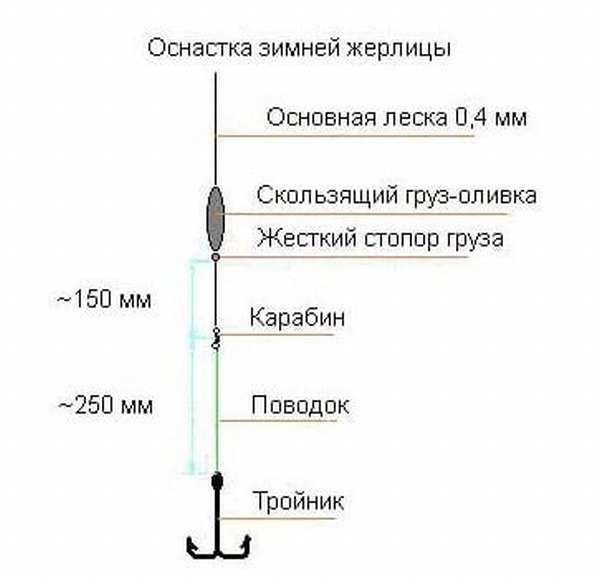
As a sinker, you can use any sliding options - it is more important to choose the right weight. Usually it is 10-15 grams. When fishing in deep water (or in the current, or when using large live bait), you will need a heavier load. The hole in the weight should not damage the fishing line. You can paint it in dark green or brown tones, but most often they don’t bother.
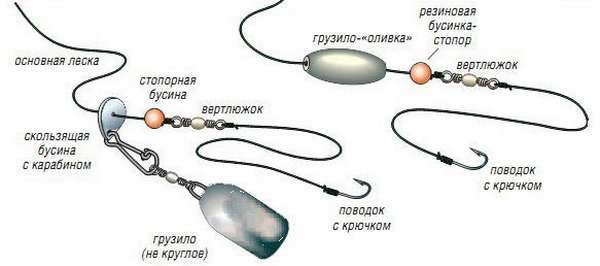
Some anglers consider equipping a winter lure for pike with a leash as a mandatory measure, while others complain that the use of this element of equipment greatly reduces the number of bites. Here you need to be guided by the following aspects.
- During the hot season (the first and last ice, active biting during the thaw) in winter, it is necessary to place leashes on the pike girders. At this time, the predator greedily swallows the bait, and there is a high probability of cutting the fishing line. You can use any store-bought leashes made of wire, tungsten, nichrome or Kevlar.
- In the dead of winter, the equipment of a girder for winter pike fishing with a leash is not necessary. It's even harmful. It is better to use high-quality fluorocarbon instead of a leash (you can double it). A special transparent leader material is also suitable.
- When choosing (or making) leashes, you should pay attention to high-quality accessories - fasteners and swivels. Cheap, low-quality parts can fail you when landing a trophy specimen.
- The rule for choosing a leash is one - for catching active fish, strength is more important, and for passive fish, the invisibility of the equipment is more important.

It is more convenient to have a set of leashes with you, and they are attached to the equipment using the loop-to-loop method (for quick change). During periods of active feeding, when the pike deeply swallows live bait, the angler does not waste time unhooking the hooks from the stomach or esophagus of the fish, but unfastens the leash and attaches a spare one instead. It is better to store a supply of leashes in a special leash holder or in a strip of polyurethane foam from a camping mat to prevent the hooks from rusting.
Different hooks are used for pike in winter; there is no consensus on this matter. When using small live bait and catching passive, cautious fish, it is better to use single hooks, in other cases - doubles or tees. It is necessary to monitor the sharpness of the sting and the presence of a beard. Naturally, low-quality hooks that bend or break easily are not suitable for pike fishing.

Fine equipment for deep winter
How to assemble a pike rig for winter fishing in the middle of nowhere? The predator at this time is sluggish and cautious; nothing should alert him. At such times, it is better to use thinner equipment. At this time and closer to spring, pike prefers small live bait. Therefore, the equipment of flags for catching pike in winter during this period is made thin, inconspicuous, but durable. The main line is fluorocarbon with a diameter of about 25 and thinner (for small pike). To attach live bait, a single hook is used; a leash is not used. If, nevertheless, the predator cuts the fishing line and does not take it to the metal, then the leash can be braided with a fluorocarbon braid. In this case, each twisted thread is separately tied to a hook.
An article about catching pike with girders in the middle of nowhere.
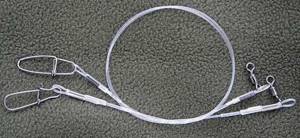
Homemade leader made from leader material or thick fluorocarbon:
For fishing in shallow water or currents
Sometimes the situation requires installing pike stands in winter close to the shore, where the layer of water under the ice does not exceed half a meter. In principle, in such conditions, conventional equipment is used, but for greater mobility of live bait, it is better to remove the sinkers. Accurate depth measurements are more important here. In the working position, the live bait must be located precisely in this layer of sub-ice water, otherwise the toothy fish simply will not find the fish.
When fishing in the current, the flag for pike turns into a winter donka. To hold the bait in place, a heavy blind weight is attached to the end of the main line (so as not to be carried away by the current), and the leash is mounted as a branch above.
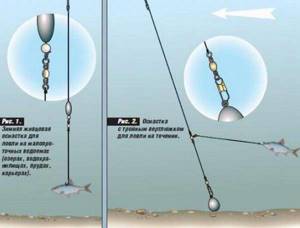
For fishing in snags and reeds
The equipment of a pike rig in winter for fishing in snags requires a more durable one, allowing you to drag it “like a fool.” You can include an additional tee in the installation diagram by passing a leash through its ring. You will get an additional sliding hook. In this case, the lower double is inserted under the gills into the mouth, and the upper tee clings to the back. It is important to quickly hook the pike so that the predator does not have time to unwind the tackle and lead it into snags or reeds. Accordingly, the free flow of the fishing line is limited to 1-1.5 meters, after winding which you need to immediately hook it. Conventional rigs with a long stroke are recommended to be placed 5-7 meters from snags, but blind rigs can be placed in the wilds or narrow reed windows. The percentage of catches in the case of passive biting in such conditions is higher, but the probability of catching a toothy one is higher.

Making a summer girder
As mentioned above, making such gear yourself is not at all difficult. Making your own gear allows you to take into account all the fishing subtleties and fishing conditions. For novice fishermen, this is not entirely clear, since they have not yet mastered the intricacies of fishing.
Classic zherlitsa - flyer
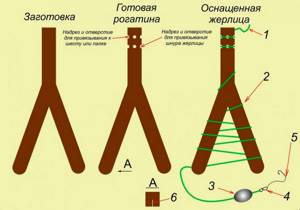
This is the simplest design, the principle of operation of which has remained unchanged for many centuries. Such gear is successfully used in our time, since it can be made directly near a reservoir, with minimal waste of time and components.
Preparation method
- First, you need to find bushes near the pond. After this, cut off the flyer, about 1 cm thick. The length of two branches should be 10-15 cm, and the length of one branch from which the branching is 5-7 cm. It is better if this flyer is dry, as it can be much stronger , unless it is very old and rotten. For regular use (not one-time use), it is better to choose a thicker material. The main thing is that the line is freely released from the workpiece.
- At the branched ends, you need to make clefts located on the same line, but not parallel to each other. They are designed to secure the fishing line. At the thick end of the flyer, a cutout is made in a circle, which will serve for attaching the gear. If you have something, you can make a hole in this place, which will make the fastening more reliable.
- A fishing line is taken, 0.4-0.5 mm thick, 5-7 meters long than the depth of the reservoir. When the fishing line is tied to the hole, they begin to wind it in a figure eight around the branched ends of the flyer.
- A snap ring should be attached to the end of the line, then a sinker and swivel should be attached, and then another snap ring should be installed. The rings will serve as limiters for the load to slide along the fishing line.
- A swivel is tied to the end of the fishing line.
- A leash is attached to the swivel. This can be a metal leash, about 30 cm long. The leash is attached with a carabiner.
- The hook is connected to a metal leash by means of a winding ring. If the leash is homemade, then the hook can be installed during the process of making the leash.
- After installation, the zherlitsa must be securely tied with a rope to some object located on the shore.
Tackle summer zherlitsa. Flyer. Slingshot. Catching pike with live bait. Fishing. Fishing.
Zherlitsa with flags
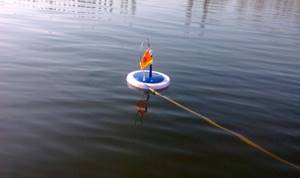
Almost all ice fishing poles are equipped with signal flags. Similar girders can be used in the summer, but you need to figure out how to fix them on the water. For summer fishing, girders with legs are more suitable, which will require a minimum of modification.
How to make
- You need to take a suitable durable material in the form of a tube or strip. A piece of wooden stick with a cross-section of 50 by 50 mm and a length of 30-40 cm is suitable, which will serve as the basis of the girder.
- The flags are installed on elastic material, for example, a piece of an old, unnecessary tape measure or a vertical piece from a plastic bottle.
- The flag rod is attached to the end of the wooden blank using electrical tape or adhesive tape. If it is an old tape measure, then it is better to nail it with small nails.
- Somewhat lower, a small inertial reel, similar to the one used on a regular float fishing rod, is attached to a wooden base. It should be secured so that when scrolling, the rod with the flag can straighten.
- The main line is wound onto the reel. It should be 15-20 m.
- A locking ring, a sinker and another locking ring are attached to the end of the fishing line.
- A swivel is attached to the end of the fishing line.
- A metal leash with a hook is connected to the swivel.
- The zherlitsa is attached by means of a wooden base to a stake or tree driven into the bank.
Summer zherlitsa with your own hands !Without the cost!
Installation of girders (flags, stakes, supplies) for pike
What does a pike bait look like in winter? There are many options for the design of the gear, but the equipment is the same. The design of a winter pike trap should provide a number of functions:
- Hold the equipment of the set length in the hole so that when a pike bites, the line is easily released and does not prevent the predator from unwinding it from the reel. At the same time, when moving in the water, live bait should not be able to pull out the fishing line and unwind it.
- Bite alarm for fisherman.
- Stable position of all equipment above the hole on ice in various weather conditions.
- Overall ease of use, deployment and transport.
There are many varieties of winter fishing poles for pike. Some models can be bought in the store. In their likeness, many anglers make their own pike flags or improve store-bought products. The tackle for pike in winter is essentially a reel with fishing line with the ability to secure the equipment in the working position. At the same time, when a predator bites, it easily pulls out the fixed equipment and moves to the side when it grabs, but live bait is not able to do this. The alarm system is made of spring or pendulum elements with a flag or other bright object visible from afar. When bitten, these elements are also released or raised, fixing the unwinding.

Types of girders for pike in winter:
- On a flat platform screen. The base of the tackle is a plane (made of plastic, metal, wood), which is installed on top of the hole, protecting it from freezing. The plane has a cut for passing fishing line and a mount with a reel and a flag on top. When installed, the flag on the metal spring bends and rests against the reel, preventing it from unwinding under the influence of the current, weight and movements of the live bait with the sinker. But the jerk of the predator is enough for the flag to rise, the reel to become free and the line to begin to reel in. This is probably the best and most popular design. Fishing stores sell plastic collapsible flags, and many ice fishermen make homemade variations of such flags. When purchasing, it is important to evaluate the quality of the plastic so that it does not break when thrown onto ice, especially at low ambient temperatures.
- On a crossbar (rail, tube, board). The second most popular design. It is a strip (board) about 30 cm long (wider than the diameter of any hole). A coil, a wire flag on a spring and two staples are attached to the crossbar. In the working position, the flag is inserted between the brackets. A loop of fishing line is wound through them from above. When the fish bites, the loop is pulled out, the flag is released and the line is reeled in freely. The main advantage of this gear is its ease of manufacture. Our grandfathers made such winter pike stakes with their own hands. It’s easy to make them yourself and quickly from scrap materials. The disadvantage of a relatively platform pier is the lack of a protective screen for the hole.

- Other options - on a peg, on a tripod (legs), upside-down crosses, magazine hatchets - have disadvantages that the above-described designs do not have. And the main disadvantage is an unstable position on the ice. It is impossible to stick a peg into the ice if there is no snow, and tripods or shifters are unstable in the wind.
Refinement and improvement of factory vents - video:
Above and below the ice
All of the above options are over-ice girders for active fishing. They imply constant monitoring of them and maintenance of the holes (clearing ice). In Siberia, the North and in rural areas, when the reservoir is often visited and the pike's anchorage areas are known, under-ice girders (postavushki, kolobashki) are more often used. It is advisable to use such gear for leaving it on a pond overnight and checking it in the morning. In the North, the practice is to permanently install shelters throughout the winter. To do this, two holes are drilled nearby. In one, the tackle is hung on the crossbar (all the equipment, including the reel with fishing line, is placed under the ice, in the water), the hole is left there and freezes. Maintenance, checking, fishing is carried out through the second hole.
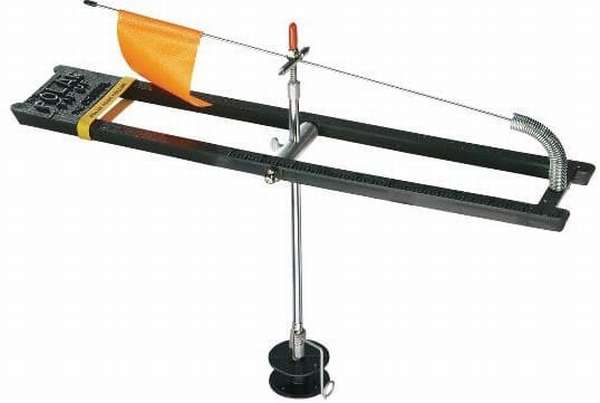
To get the equipment, it is picked up with a special wire poker (hook), and after reloading it is lowered into the water again. The reel itself with a slot (split) for fishing line was previously made of wood and was called a kolobashka (kolobakha). Now it is more advisable to use plastic reels, for example, from yogurt bottles filled with sand (so that they do not float). The line comes off well when unwinding. This principle is the progenitor of all spinning reels. Such a pike rig can last until the ice melts. If the hole is frozen, it’s okay, you can drill a new one nearby (or break the old one with an ice pick). In general, an ice pick is a very necessary tool for a girder. If a fisherman decides to get serious about fishing rods, then he will need to acquire such a tool.
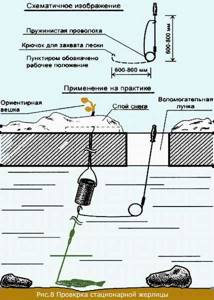
Some features of fishing with girders
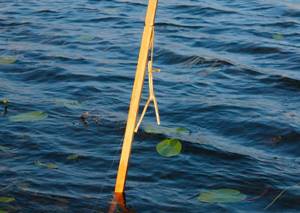
For beginners, the following instructions may be useful:
- The load must be such that the live bait can move only in a certain area of the reservoir. Otherwise, he can simply hide in nearby thickets.
- The stake to which the pier is attached on the shore must be of sufficient length. If the stake is dry, it should be tested for strength. It would be a pity if it couldn’t withstand the pressure of a serious specimen.
- If the bottom is rocky, then the girder can be tied to a stone, while the girder itself can be on the surface of the water.
- The fixation of the fishing line should not be noticeable to the pike. If she feels resistance, she may refuse to bite and spit out the bait.
- Live bait is placed on a hook in the area of the upper fin, although there are other ways to place a fish on a hook. This is especially true when fishing in the current.
